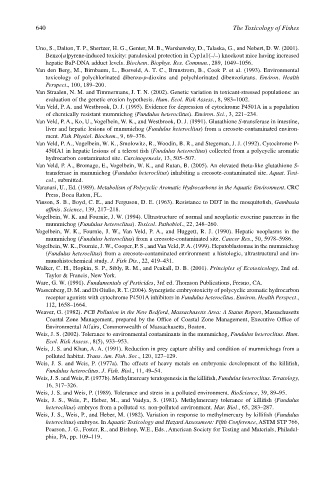Page 660 - The Toxicology of Fishes
P. 660
640 The Toxicology of Fishes
Uno, S., Dalton, T. P., Shertzer, H. G., Genter, M. B., Warshawsky, D., Talaska, G., and Nebert, D. W. (2001).
Benzo[a]pyrene-induced toxicity: paradoxical protection in Cyp1a1(–/–) knockout mice having increased
hepatic BaP-DNA adduct levels. Biochem. Biophys. Res. Commun., 289, 1049–1056.
Van den Berg, M., Birnbaum, L., Bosveld, A. T. C., Brunstrom, B., Cook P. et al. (1993). Environmental
toxicology of polychlorinated dibenzo-p-dioxins and polychlorinated dibenzofurans. Environ. Health
Perspect., 100, 189–200.
Van Straalen, N. M. and Timmermans, J. T. N. (2002). Genetic variation in toxicant-stressed populations: an
evaluation of the genetic erosion hypothesis. Hum. Ecol. Risk Assess., 8, 983–1002.
Van Veld, P. A. and Westbrook, D. J. (1995). Evidence for depression of cytochrome P4501A in a population
of chemically resistant mummichog (Fundulus heteroclitus). Environ. Sci., 3, 221–234.
Van Veld, P. A., Ko, U., Vogelbein, W. K., and Westbrook, D. J. (1991). Glutathione S-transferase in intestine,
liver and hepatic lesions of mummichog (Fundulus heteroclitus) from a creosote-contaminated environ-
ment. Fish Physiol. Biochem., 9, 69–376.
Van Veld, P. A., Vogelbein, W. K., Smolowitz, R., Woodin, B. R., and Stegeman, J. J. (1992). Cytochrome P-
450IA1 in hepatic lesions of a teleost fish (Fundulus heteroclitus) collected from a polycyclic aromatic
hydrocarbon contaminated site. Carcinogenesis, 13, 505–507.
Van Veld, P. A., Bromage, E., Vogelbein, W. K., and Rutan, B. (2005). An elevated theta-like glutathione S-
transferase in mummichog (Fundulus heteroclitus) inhabiting a creosote-contaminated site. Aquat. Toxi-
col., submitted.
Varanasi, U., Ed. (1989). Metabolism of Polycyclic Aromatic Hydrocarbons in the Aquatic Environment. CRC
Press, Boca Raton, FL.
Vinson, S. B., Boyd, C. E., and Ferguson, D. E. (1963). Resistance to DDT in the mosquitofish, Gambusia
affinis. Science, 139, 217–218.
Vogelbein, W. K. and Fournie, J. W. (1994). Ultrastructure of normal and neoplastic exocrine pancreas in the
mummichog (Fundulus heteroclitus). Toxicol. Pathobiol., 22, 248–260.
Vogelbein, W. K., Fournie, J. W., Van Veld, P. A., and Huggett, R. J. (1990). Hepatic neoplasms in the
mummichog (Fundulus heteroclitus) from a creosote-contaminated site. Cancer Res., 50, 5978–5986.
Vogelbein, W. K., Fournie, J. W., Cooper, P. S., and Van Veld, P. A. (1999). Hepatoblastomas in the mummichog
(Fundulus heteroclitus) from a creosote-contaminated environment: a histologic, ultrastructural and im-
munohistochemical study. J. Fish Dis., 22, 419–431.
Walker, C. H., Hopkin, S. P., Sibly, R. M., and Peakall, D. B. (2001). Principles of Ecotoxicology, 2nd ed.
Taylor & Francis, New York.
Ware, G. W. (1991). Fundamentals of Pesticides, 3rd ed. Thomson Publications, Fresno, CA.
Wassenberg, D. M. and Di Giulio, R. T. (2004). Synergistic embryotoxicity of polycyclic aromatic hydrocarbon
receptor agonists with cytochrome P4501A inhibitors in Fundulus heteroclitus. Environ. Health Perspect.,
112, 1658–1664.
Weaver, G. (1982). PCB Pollution in the New Bedford, Massachusetts Area: A Status Report, Massachusetts
Coastal Zone Management, prepared by the Office of Coastal Zone Management, Executive Office of
Environmental Affairs, Commonwealth of Massachusetts, Boston.
Weis, J. S. (2002). Tolerance to environmental contaminants in the mummichog, Fundulus heteroclitus. Hum.
Ecol. Risk Assess., 8(5), 933–953.
Weis, J. S. and Khan, A. A. (1991). Reduction in prey capture ability and condition of mummichogs from a
polluted habitat. Trans. Am. Fish. Soc., 120, 127–129.
Weis, J. S. and Weis, P. (1977a). The effects of heavy metals on embryonic development of the killifish,
Fundulus heteroclitus. J. Fish. Biol., 11, 49–54.
Weis, J. S. and Weis, P. (1977b). Methylmercury teratogenesis in the killifish, Fundulus heteroclitus. Teratology,
16, 317–326.
Weis, J. S. and Weis, P. (1989). Tolerance and stress in a polluted environment. BioScience, 39, 89–95.
Weis, J. S., Weis, P., Heber, M., and Vaidya, S. (1981). Methylmercury tolerance of killifish (Fundulus
heteroclitus) embryos from a polluted vs. non-polluted environment. Mar. Biol., 65, 283–287.
Weis, J. S., Weis, P., and Heber, M. (1982). Variation in response to methylmercury by killifish (Fundulus
heteroclitus) embryos. In Aquatic Toxicology and Hazard Assessment: Fifth Conference, ASTM STP 766,
Pearson, J. G., Foster, R., and Bishop, W.E., Eds., American Society for Testing and Materials, Philadel-
phia, PA, pp. 109–119.

